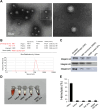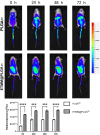Mechanism of engineered macrophage membrane bionic gene-carrying nanospheres for targeted drug delivery to promote wound repair in deep second-degree burns
- PMID: 39843907
- PMCID: PMC11754751
- DOI: 10.1038/s41598-025-86716-2
Mechanism of engineered macrophage membrane bionic gene-carrying nanospheres for targeted drug delivery to promote wound repair in deep second-degree burns
Abstract
Hepatocyte growth factor (HGF) is a substance that stimulates the proliferation of hepatocytes which promote healing. We developed a macrophage membrane-encapsulated nanosphere drug delivery system containing HGF for the study of burn wound healing. Twenty-seven Sprague-Dawley rats were randomly divided into three groups: a saline control (NS) group, an engineered macrophage membrane-encapsulated nanospheres (ETMM@NPS) group, and an engineered macrophage membrane-encapsulated nanospheres treatment with HGF-loaded gene (HGF@ETMM@NPS) group.The wound tissue sections were examined histologically using hematoxylin and eosin (H&E) and Masson trichrome staining. Immunohistochemistry and Western blotting were performed to determine the expression of relevant proteins. The wound-healing, blood flow and complete epithelialization rates were significantly better in the HGF@ETMM@NPS group compared to the NS and ETMM@NPS groups. Expression of B-cell lymphoma 2-associated X-protein was significantly lower, and B-cell lymphoma 2, cluster of differentiation 31, HGF, alpha smooth muscle actin, and PCNA expression was significantly higher in the HGF@ETMM@NPS group compared with the other two groups. PCNA and HGF expression was significantly up-regulated in the HGF@ETMM@NPS group. The HGF@ETMM@NPS complex drug delivery system used in this research promoted wound healing via effective delivery of HGF to burn wounds, thereby accelerating skin cell growth and migration.
Keywords: Deep second-degree burns; Engineered macrophage membranes; PLGA nanospheres; Targeted drug delivery system; Trabecular repair.
© 2025. The Author(s).
Conflict of interest statement
Declarations. Competing interests: The authors declare no competing interests. Ethical statement: The study is reported in accordance with ARRIVE guidelines.The animal experiments of the study were reviewed and approved by the Animal Experiment Ethics Committee of Nantong University.
Figures











Similar articles
-
Effects of mesenchymal stem cells transfected with human hepatocyte growth factor gene on healing of burn wounds.Chin J Traumatol. 2010 Dec;13(6):349-55. Chin J Traumatol. 2010. PMID: 21126393
-
Porous Se@SiO2 nanosphere-coated catheter accelerates prostatic urethra wound healing by modulating macrophage polarization through reactive oxygen species-NF-κB pathway inhibition.Acta Biomater. 2019 Apr 1;88:392-405. doi: 10.1016/j.actbio.2019.02.006. Epub 2019 Feb 10. Acta Biomater. 2019. PMID: 30753941
-
[Effects and mechanism of rat epidermal stem cells treated with exogenous vascular endothelial growth factor on healing of deep partial-thickness burn wounds in rats].Zhonghua Shao Shang Za Zhi. 2020 Mar 20;36(3):195-203. doi: 10.3760/cma.j.cn501120-20191125-00441. Zhonghua Shao Shang Za Zhi. 2020. PMID: 32241045 Chinese.
-
A Composite of Hepatocyte Growth Factor- and 5α-Dihydrotestosterone-Gelatin Microspheres with Adipose-Derived Stem Cells Enhances Wound Healing.Skin Pharmacol Physiol. 2022;35(4):206-214. doi: 10.1159/000524188. Epub 2022 Apr 19. Skin Pharmacol Physiol. 2022. PMID: 35439758
-
[Effects and mechanism of hepatocyte growth factor-modified human adipose mesenchymal stem cells on wound healing of full-thickness skin defects in diabetic rats].Zhonghua Shao Shang Za Zhi. 2021 Sep 20;37(9):860-868. doi: 10.3760/cma.j.cn501120-20200626-00329. Zhonghua Shao Shang Za Zhi. 2021. PMID: 34645152 Free PMC article. Chinese.
References
-
- Ebrahimpour, N. et al. The efficacy of a traditional medicine preparation on second-degree burn wounds in rats. J. Ethnopharmacol.10.1016/j.jep.2020.112570 (2020). - PubMed
Publication types
MeSH terms
Substances
Grants and funding
LinkOut - more resources
Full Text Sources
Medical
Miscellaneous

